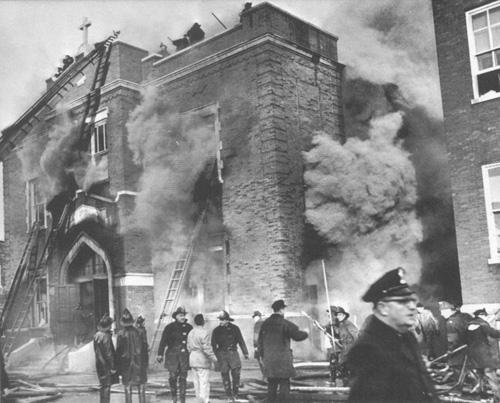After 50 years, scars from school fire remain

Fire fighters battle a blaze at the Our Lady of the Angels School in Chicago on Dec. 1, 1958. Fifty years later, schools nationwide are still adopting and using new fire safety codes to avoid similar disasters.. The Associated Press File Photo
December 1, 2008
CHICAGO – Seven-year-old Dan Taglia hoped students were getting ice cream when he heard the fire alarm from his basement classroom on Dec. 1, 1958. It was too late for a fire drill, and the nuns wouldn’t send the children out coatless on such a cold day.
“But what does a third-grader know?” recalled Taglia, now of Katy, Texas.
But the alarm was real. And tragically delayed.
Fire and toxic smoke engulfed the elementary and middle school on Chicago’s West Side with terrifying swiftness. In the end, 92 students and three nuns died.
Some of the victims burned to death. Others died of smoke inhalation or were trampled. Still others were killed when they jumped or were pushed or thrown from windows.
Get The Daily Illini in your inbox!
The disaster threw the city into mourning. It forced an almost immediate reform of school building and safety codes in Chicago and around the nation.
And it left deep physical and emotional scars that remain 50 years later.
For many, the only way out was through the windows – 25 feet above the paved schoolyard.
Once fire fighters arrived with hoses and long ladders, they had no choice but to reach as far as they could into the burning classrooms, grab children and toss them down – hoping someone below would catch them.
In retrospect, conditions at the school appear to have been a disaster waiting to happen.
It was in the midst of the Baby Boom, when classroom overcrowding was the national norm, school construction was largely unregulated and safety features were primitive, at best.
The construction of the school, which would be unthinkable today, was completely legal under grandfather clauses in Chicago’s school building code of the time.
In the school there was just one steel fire escape but it was locked. The fire alarm was not connected to the Chicago Fire Department’s system, and its switches were six feet off the floor – too high for most students to reach.
In the year after the fire, 16,500 older school buildings across the nation underwent various forms of fireproofing, and the National Fire Protection Association estimates that 68 percent of U.S. communities followed Chicago’s lead in adopting new school fire codes.






